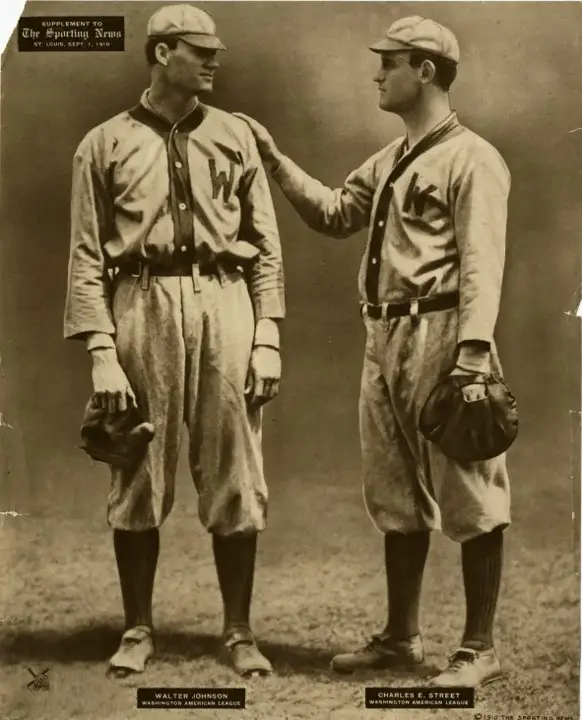The world's tallest building was nearing completion in Washington in 1884. Standing just over 555 feet tall, the Washington Monument eclipsed the Cologne Cathedral in Germany for the height crown.
Even before it opened, ballplayers for both Washington and visiting clubs found it tantalizing.
Opinions differed as to whether a human being could catch a baseball tossed from its 50-story height. Like Mount Everest, which had to be climbed "because it was there," the monument inspired players to take up the challenge.

The First Attempt
The first known attempt is shrouded in mystery, as surviving newspaper accounts are in conflict on key details-such as whether any balls were actually caught. Outfielder Paul Hines and catcher Phil Baker, were among a half-dozen players who embarked upon the task.
Hines couldn't convince anyone to climb the not-quite-completed tower to launch the ball, so a workman was engaged. According to the Washington Post, the ball was thrown from one of the small windows about 50 feet from the top, "with some force in an outward direction."
The first ball landed on top of a shed, and the second disappeared into a nearby lake or pond. Hines got a hand - an ungloved one, as was the custom for outfielders in 1884 - on the third ball, but it apparently skipped off his fingers.
Though the ball would have been moving at tremendous speed by the time Hines reached it, he felt that it did not sting any worse than some of the liners he routinely grabbed in center field.
Another paper reported that Phil Baker took up the challenge after Hines, and that the catcher-also gloveless, dove to catch one of the tosses, breaking two knuckles in the process. Still another paper, while confirming the bone breaks, reported that the ball popped out of Baker's valiant hand.
Attempt #2
The next man to attempt the catch was William "Pop" Schriver, catcher for the visiting Chicago Colts (Now the Cubs) on August 25, 1894.
Chicago was managed by Cap Anson, who bet the manager of the Arlington Hotel that the feat could be accomplished. Chicago pitcher Clark Griffith, who would later pitch for, manage, and ultimately own the Washington Senators, sneaked to the top of the monument and let the horsehide fly.
Schriver let the first pitch go by, but his nerves were calmed upon seeing the ball bounce only ten feet. He promptly caught Griffith's second toss before the team was driven away by an indignant security guard.
Or did the ball glance off of his mitt?
Again, sources differ. Shriver did catch something for sure that day-The Colts loss to the Senators. He was apparently no worse for wear, as he was two-for-two at the plate.
Gabby Street
The first indisputable catch off the obelisk belongs to Washington catcher Gabby Street. Journalist Preston Gibson bet a large sum on whether the feat could be accomplished. On August 21, 1908, he climbed the monument and threw ball after ball to Gabby Street.

Twelve or thirteen balls were missed in the brisk wind, with witnesses reporting that they bounced 50 feet on concrete, or dug themselves 3 inches into the ground on grass. Street was wearing a glove, but no mask, helmet, or chest protector when he at last hauled down one of the balls. The sound of the ball hitting his glove was heard for several hundred yards, and the force nearly knocked him over.
Navy ordnance experts estimated that the ball dropped at 135 feet per second, and exerted 117 foot-pounds of pressure. Street reported that it was difficult to see the ball until it was about halfway down, and that the ball "hit my mitt with terrific force...much greater than any pitched ball I have ever caught."
Indeed, that very afternoon, Street caught a lot more objects moving with impressive force, as the young Walter Johnson tossed a five-hitter.
Preston Gibson inscribed the ball with date and details, and kept it in his home at 3017 N St. NW, in Georgetown. When his son, James McMillan Gibson sold the home to former first lady Jacqueline Kennedy, the ball resurfaced and was donated to the Baseball Hall of Fame.
Billy Sullivan and the White Sox
Gabby Street's catch inspired others to try, and in 1910, White Sox catcher Billy Sullivan was successful.
The annual Reach Guide reported "Ever since Street's feat...base ball catchers the country over...have confessed to a desire to emulate it." According to the guide, "On each visit of his team to Washington, he would spend many hours gazing longingly and speculatively at the top of the big stone shaft."
White Sox hurlers Ed Walsh and Doc White heaved about 40 balls down at Sullivan, who managed to catch three of them.
Catches From Other Extreme Heights
With the monument conquered twice in three years, players turned their attention to higher targets. Since not many buildings were taller, they began to attempt to catch balls thrown from blimps and airplanes.
The pinnacle of such achievements came in the 1930s, when Gabby Hartnett and several others were successful in catching blimp tosses of between 600 and 800 feet. The practice came to a halt in 1939, when San Francisco Seals catcher Joe Sprinz caught a ball dropped 800 feet from a blimp.
Unfortunately, the force of the ball, traveling an estimated 145 miles per hour, knocked his glove into his face, shattering his jaw and displacing several teeth. Sprinz missed a month of the season, and suffered severe headaches for the next four years.
The record catch from a building was set just the previous year, when Cleveland Indians catchers Hank Helf and Frank Pytlak each caught balls thrown by Ken Keltner from the 708-foot terminal tower in Cleveland, a feet which was reenacted in 1980 by a professional softball team.
Starting and Finishing with Gabby Street
Gabby Street achieved great notoriety for his 1908 catch, and relived it in 1945. As part of a promotion to sell war bonds, he teamed with his rookie broadcast partner, a kid named Harry Caray, to reenact the catch in St. Louis. Caray threw four balls from the roof of the 387-foot Civil Court Building, and the 63-year-old Street caught two of them.
"Those were my greatest catches, greater than the monument," mused Street, 33 years after he became the first man to conquer the obelisk.
Scott Perry
Scott Perry is the owner and lead author at Catchers Home. He's a former baseball player, a current coach, a husband and a Dad. He remains as passionate about baseball today as he was as a kid.

